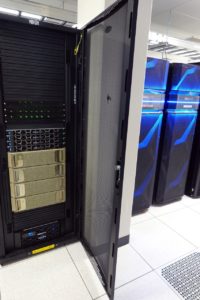How the USPS Is Finding Lost Packages More Quickly Using AI Technology from Nvidia

With hundreds of millions of pieces of mail to process and deliver daily, the U.S. Postal Service is always looking for ways to streamline its technology systems to improve its services.
Since the early 2000s, those technologies have included bringing in HPC and machine learning, which have continued to be added incrementally over the years to solve new problems and challenges with mail delivery to some 150 million addresses that go through thousands of local post offices each day.
In one of its latest technology innovations, the USPS got AI help from Nvidia to fix a problem that has long confounded existing processes – how to better track packages that get lost within the USPS system so they can be found in hours instead of in several days. In the past, it took eight to 10 people several days to locate and recover lost packages within USPS facilities. Now it is done by one or two people in a couple hours using AI.
For the post office, this is a transformative use of AI, Todd Schimmel, the manager who oversees the USPS systems including the Edge Compute Infrastructure Program (ECIP) that finds the lost packages, told EnterpriseAI.
“USPS is constantly looking at new technologies and their potential applications to our business,” said Schimmel. “One of the core missions of my group and of engineering systems is to explore and evaluate new technologies. We have a few folks in my group who started experimenting with AI/ML to see if there could be benefits to the image processing and handling within the USPS.”
Those experiments led to the agency contracting with technology consultants Accenture to get the project off the ground and with Nvidia to help create a path to solving the lost package problem.

These are the Nvidia DGX servers where the AI algorithms were developed at a U.S. Postal Service engineering facility. Image courtesy of Nvidia.
To do this, the ECIP distributed edge AI system was built upon Nvidia EGX platforms each running four Nvidia V100 Tensor Core GPUs in HPE Apollo 6500 servers. Each edge server processes 20 terabytes of images a day from more than 1,000 mail processing machines, according to Nvidia. The systems are managed by Nvidia's open source Triton Inference Server software, which acts like a "digital mailperson," delivering AI models to each of the mail processing systems located in the 195 mail processing centers operated by the USPS.
The AI models were trained using Nvidia DGX platforms and then deployed on Nvidia EGX machines.
Nvidia began working in the fall of 2019 with a USPS AI architect to prototype and test initial concepts. The program came together quickly, with a USPS data scientist, half a dozen Nvidia architects and others designing the deep learning models needed for ECIP in just three weeks. USPS awarded the contract in September 2019, started deploying systems in February 2020 and finished most of the hardware by August of 2020, according to Nvidia.
A previous engineering analysis of the computer vision problems that stood in the way of the lost package problem determined that the USPS would require two weeks of calculations on a network of servers with 800 CPUs to do what can now be done in 20 minutes using the Nvidia systems now in place, said Schimmel.
The system uses the same photographic images of packages that are already being taken and used by the post office within its mail handling automation systems that process package barcodes and evaluate addresses. Images are automatically taken of packages as they go through the systems.
“For address resolution, USPS has been using AI since the early 2000s,” said Schimmel. “The new AI/ML algorithms are being used to categorize parcels for various internal business needs that include a reverse image search. This enables USPS stakeholders to troubleshoot and diagnose pieces with anomalies in processing.”
Reverse image searches use the images in the system and allow postal workers to comb through thousands of images to find the lost packages they are seeking.
So far, the system to find lost items is only being used to find packages, not letters or other mail such as magazines. The postal equipment uses Optical Character Readers (OCR) or barcode data to recognize the addresses and then the machines use this information to sort packages into bins for delivery.
“Reviewing the technologies available, AI/ML was the best choice for the needs of the stakeholders,” said Schimmel. “The implementation of the algorithms’ automated processes that had been done manually was quite laborious.”
The OCR processing works with AI to help the system do its work, he said.
“AI is used within the OCR software algorithms,” he explained. “Handwriting is quite difficult to solve without AI due to the significant variances in each individuals writing style. With AI, the systems are able to deduce that the word ‘hello’ in cursive has a certain pattern. It then compares this pattern to its previously trained data and says – this must mean “hello.’”
The USPS has also been using GPU-powered analytics to improve its operations since 2014.
 Anthony Robbins, the vice president of Nvidia’s federal business markets, said in a briefing with reporters that the USPS used 13 Nvidia DGX systems across two data centers to train their algorithms using USPS data to help with finding lost packages.
Anthony Robbins, the vice president of Nvidia’s federal business markets, said in a briefing with reporters that the USPS used 13 Nvidia DGX systems across two data centers to train their algorithms using USPS data to help with finding lost packages.
“One of the most complex businesses in all of the federal government is the United States Postal Service,” said Robbins. “They have a really big enterprise. They process 40% of the world's mail. They process more than 129 billion pieces of mail a year. They process 7.3 billion packages a year, 20 million packages a day.”
It was a data scientist within the USPS who came up with the idea to use AI to solve the lost package problem and helped push it to fruition, said Robbins.
“They took about a year to do the project once the benchmarks established that it was possible,” he said. “There are not many enterprise wide AI/ML computer vision projects that have been deployed at this scale, across the whole enterprise, and especially not in the case of government. That's where I think this innovation work occurring here is so unique, both in the value it brings to the Postal Service and the value it brings to transformation efforts across the federal government … and for commercial enterprises around the world.”










